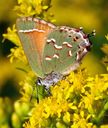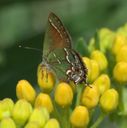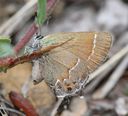Hodges#4318
Callophrys gryneus
Classification
- Phylum: Arthropoda
- Subphylum: Hexapoda
- Class: Insecta
- Order: Lepidoptera
- Superfamily: Papilionoidea
- Family: Lycaenidae
- Subfamily: Theclinae
- Tribe: Eumaeini
- Genus: Callophrys
- Species: gryneus
Pronunciation
How to pronounce Callophrys gryneus: /kəˈlɑf.rɪs ˈɡraɪ.ni.əs/
These audio files are automatically generated. While they are not always 100% accurate, they are a good starting point.
Images






Summary
Callophrys gryneus, commonly known as the juniper hairstreak or olive hairstreak, is a butterfly native to North America that uses various species of junipers as host plants with multiple subspecies identified based on coloration and habitat.
Physical Characteristics
Males have tawny orange or bronzy wings while females are blackish brown. Undersides are bright green with varying brown scaling, decorated with white postbasal spots and a zigzag white postmedian line edged in brown on the hindwing.
Identification Tips
Distinct markings in the discal area of the lower hind wing; eastern populations are generally green below with these markings, while western populations lack them and are often brownish.
Habitat
Semi-open areas such as bluffs, open fields, barrens, and dry or rocky open places, often found near juniper trees.
Distribution
Widely distributed across the United States, southern British Columbia, and southern Ontario.
Diet
Adults take nectar from flowers near the host plant and can be seen mud-puddling.
Life Cycle
Males are territorial and perch on cedar trees; eggs are laid singly at the tips of host plant leaves. The species has two broods per year for some races and one brood for others.
Reproduction
Females lay eggs singly on host plants. Males exhibit territorial behavior.
Ecosystem Role
Serves as a pollinator and part of the food web as both larva and adult.
Collecting Methods
- Netting adults in flight
- Surveying host plants for eggs and larvae
Preservation Methods
- Freezing specimens
- Drying and mounting on pins
Evolution
Adapted to use conifers as larval hosts, possibly evolving from ancestors that utilized parasitic mistletoe on conifers.
Similar Taxa
Misconceptions
Some populations might be confused with other hairstreak species due to similar coloration and patterns.
Tags
- butterfly
- Lepidoptera
- Callophrys gryneus
- juniper hairstreak
- Lycaenidae